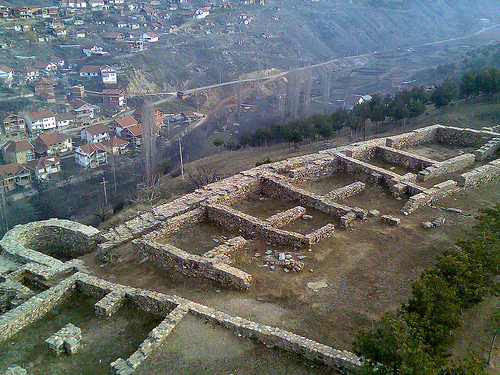

Location: Vinica Map
Viničko Kale is situated on a strategic hill overlooking village of Vinica in the eastern Republic of Macedonia. This is an important archaeological site those first settlements date back to the ancient times around 2200 BC. Some of the oldest Christian icons from the 4th and 6th century were discovered here. Today 25,000 square metres of the historic settlement still undergo exploration by the historians and archaeologists. Most of the artefacts discovered here are presented in the Macedonian capital of Skopje.
It is located southwest of the
town of Vinica, to the left of Grdecka Reka, on an irregularly
shaped hill, elongated in the southeast-northwest direction, with an
altitude of 400 m. It is surrounded by steep sides, with the
exception of the southeast, which is separated from the adjacent
height by a deep and wide artificial trench. It has an uneven peak,
with a slope to the northwest, where the height difference reaches
up to ten meters. The size of the space occupied by the remains of
the fortification has approximate dimensions of 250 × 150 m, which
is about 2.5 ha. According to the surface remains, the settlement
spread on the slopes of the hill, as well as on the surrounding
hills. With its height and position, the site dominates over the
area of Vinica, and has a beautiful view over the riverbed of
Bregalnica.
Archaeological excavations
Vinica Fortress as
an archeological site was discovered in 1954 by M. Grbiќ, under the
name "Gradischte", and later, in 1958, M. and D. Garashanin
introduced the term "Kale Bair". Interest in his research arose in
1978, when archaeologist C. Krstevski brought to the Museum of
Macedonia five fragments of terracotta reliefs with iconographic
representations, hitherto unknown, especially interesting for the
study of the early Christian period. Thus, since 1985,
archaeological excavations have begun that continue unabated to this
day. Initially, the relative stratigraphy of the site was found as
protective, and later systematically, with these excavations.
According to the archeological findings, especially the ceramic
ones, the life in the settlement took place in a long continuity,
from the Neolithic period until the full Middle Ages, with the
difference that the most numerous architectural remains from the
late antique period (IV century-V century). Remains of walls of
several buildings of a profane character were discovered, with
organized porches, "benches" for sitting, warehouses, built of stone
and lime mortar, which in some places have been preserved up to 4 m
high. Swimming pool, prefurnium, plumbing installations and more
were found in some of them. The buildings were erected next to the
defensive wall, of which a part was discovered together with a
semicircular tower. The wall is made of crushed stone and lime
mortar, and its width is 3 m. It is important to mention that in the
rubble between the walls was found a large number of whole and
fragmented replicas of terracotta icons, with invaluable
archaeological, artistic and theological value dimensions. Near the
middle of the site are very poorly preserved remains of the walls of
a small medieval church, much earlier excavated by "gold diggers" -
gold diggers. A large number of samples of architectural plastic
were discovered around the church, such as columns, bases, capitals,
parts of the chancel, transes, floor tiles, etc., and fragments of
ceramic vessels, bronze objects, iron and bone, then jewelry. ,
coins and more. A rich female tomb from the 12th century was
discovered and excavated, in which 9 glass and 4 bronze gilded
bracelets, 11 bronze rings (several gilded) and a bone object
(needle) were found.
Discoveries and results
The results
of the excavations, although still unfinished, clearly show that the
fortified settlement of Vinicko Kale was permanently exposed to ups
and downs, which is clearly seen through the construction
interventions at the facilities. Of course, his location, which lies
on one of the busiest economic ancient communications - the road
from Stobi to Pautalia and Serdica - played a big part in all that.
On this road, according to historical sources, there were several
urban settlements, hence the idea that perhaps one of the cities of
Armonia or Kalenidin was located on Vinica Fortress, which is
expected to be confirmed by further research. There are traces of
life in this site since early antiquity. In the IV century the city
received a fortification which was restored in the VI century. It is
probable that the town of Kelenidin, known from written sources as
the episcopal see, is located here. An early Christian basilica was
discovered in this site, residential and commercial premises in
which the so-called Vinica icons.
Vinica icons
These
terracotta reliefs contain iconographic representations of Christian
themes as well as Latin inscriptions with liturgical content. They
date from the 5th - 6th century and probably served as an
application on the walls of the tomb buildings in the late antique
period in the Vinica building complex. The terracotta icons from the
Vinica Fortress that were discovered by the archaeologist Cone
Krstevski are the only ones of this type with invaluable wealth of
archaeological, artistic and theological value.